This document discusses gradient boosted regression trees (GBRT) and their implementation in scikit-learn. It begins with an introduction to machine learning concepts like classification, regression, and decision trees. It then covers the basics of boosting and gradient boosting, describing how GBRT works by sequentially fitting trees to residuals. The rest of the document demonstrates scikit-learn's GBRT implementation, provides tips on regularization and hyperparameters, and presents a case study on house price prediction.




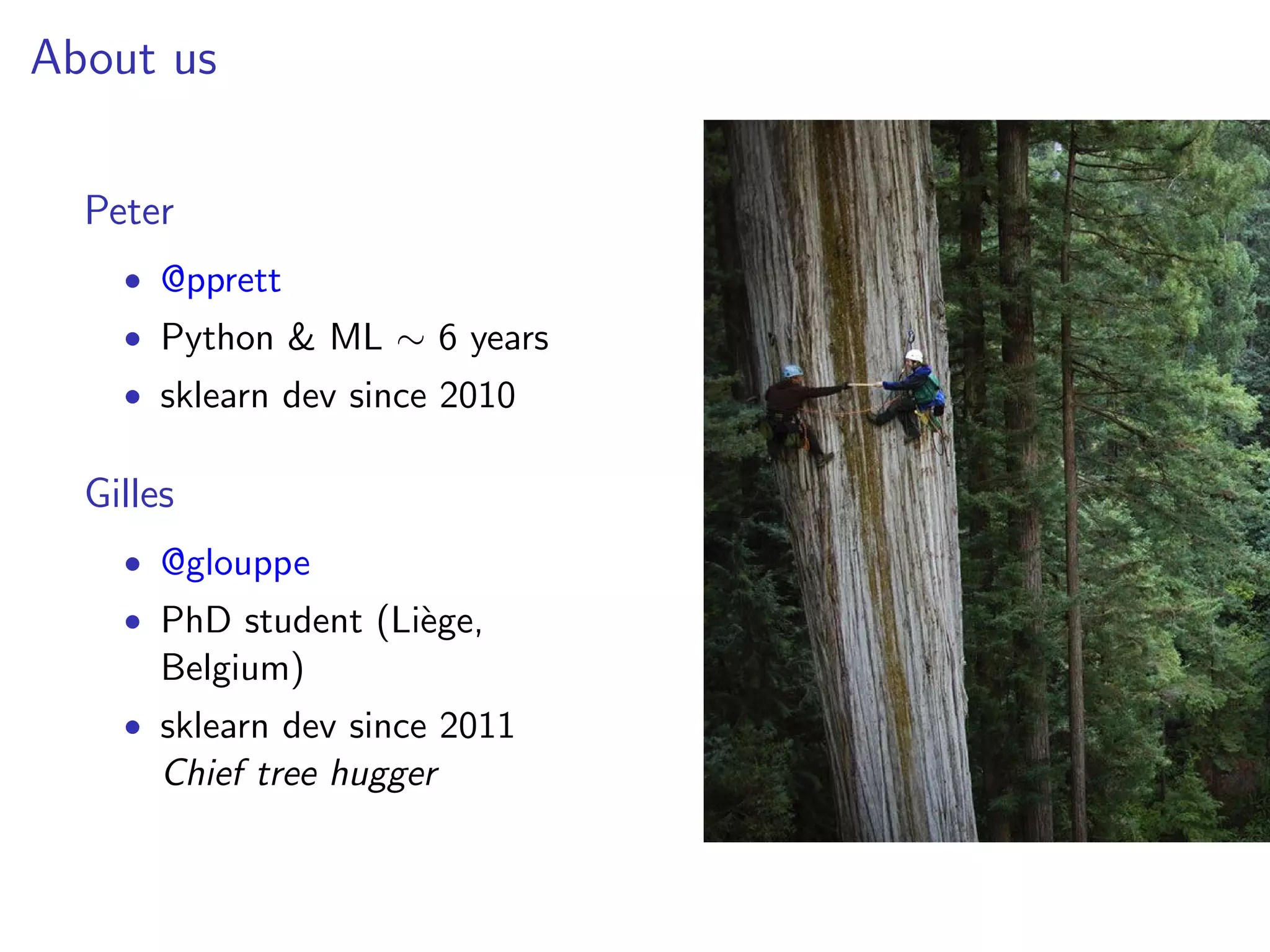
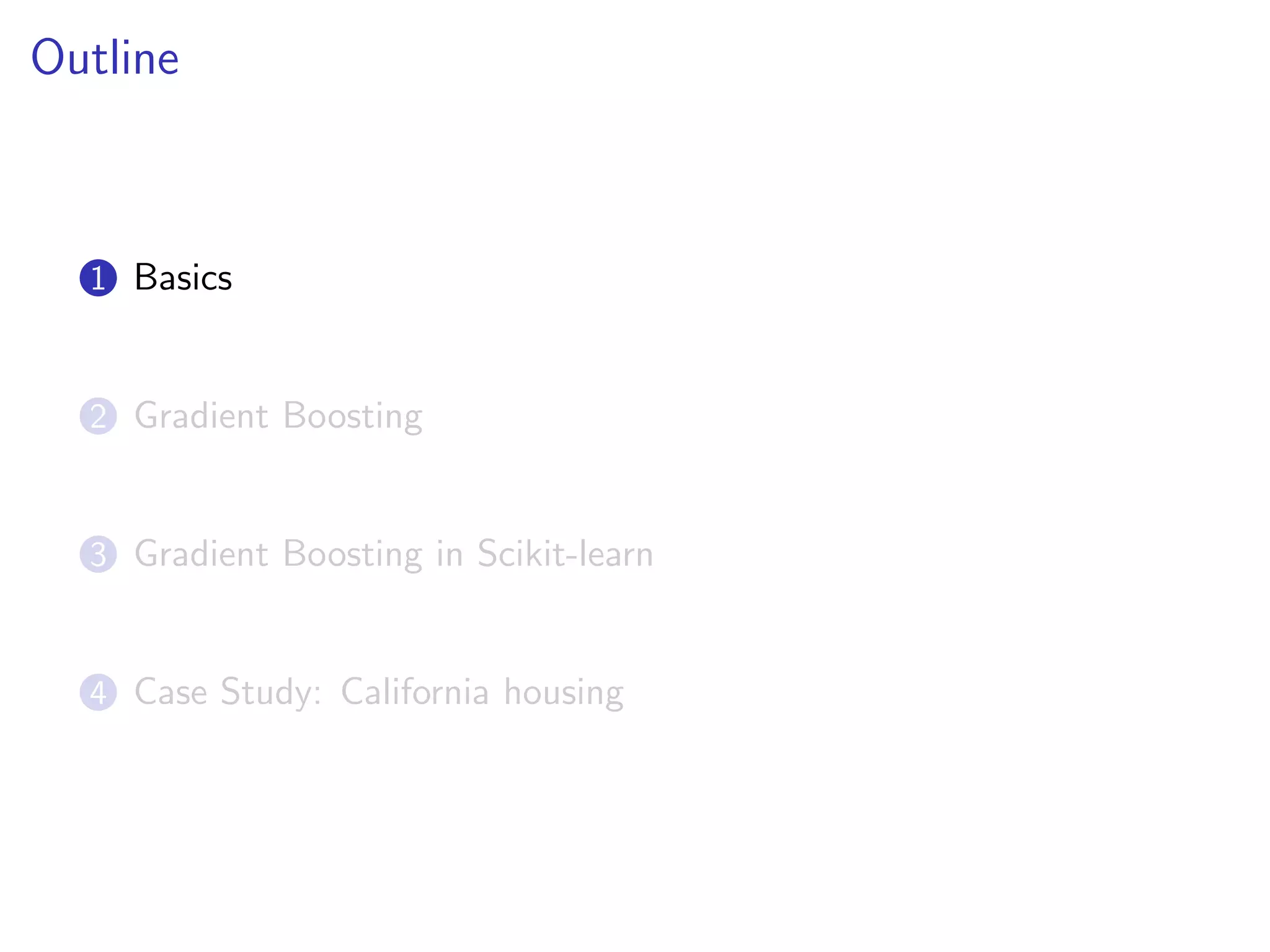
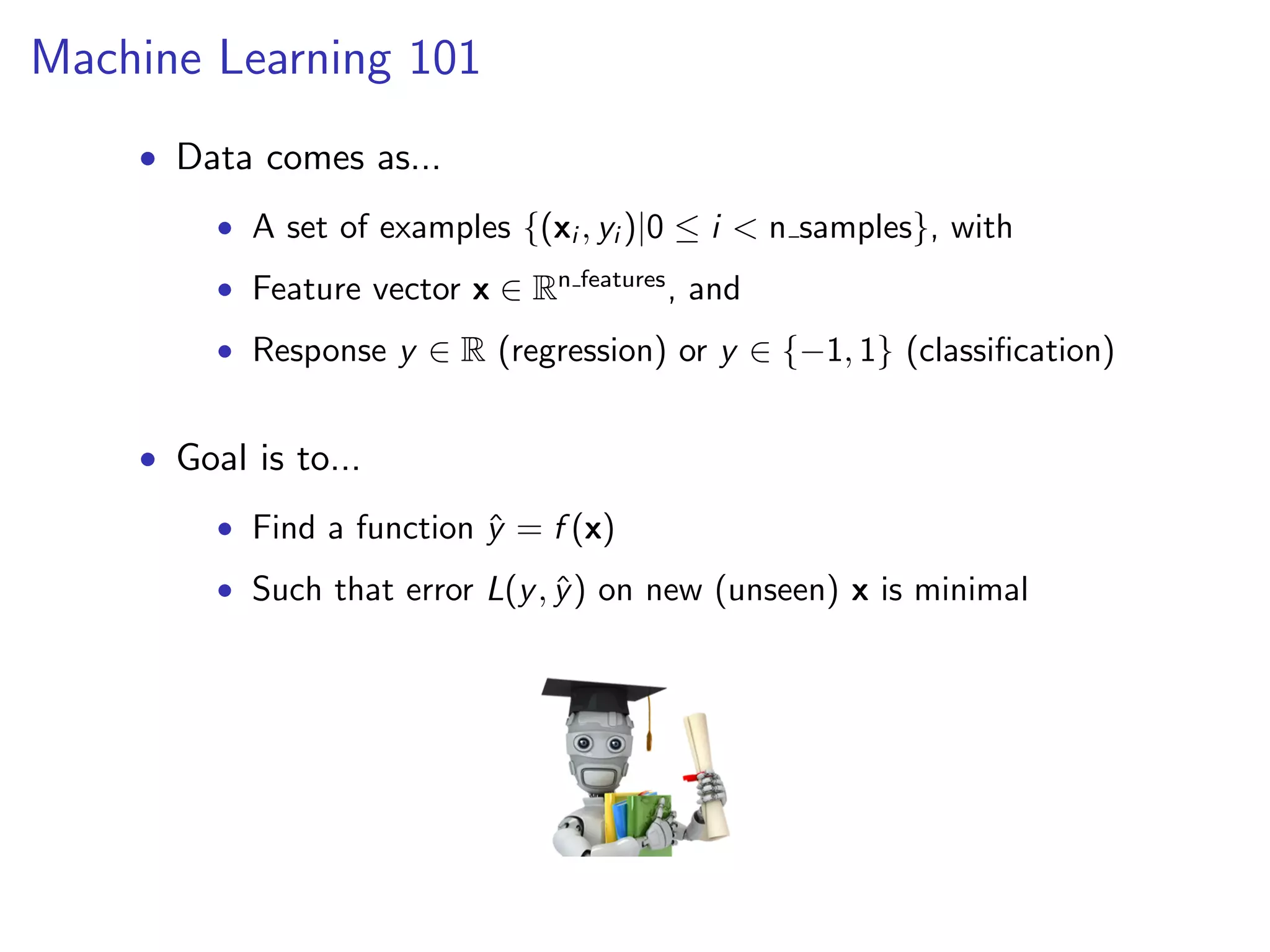
![Classification and Regression Trees [Breiman et al, 1984] MedInc <= 5.04 MedInc <= 3.07 MedInc <= 6.82 AveRooms <= 4.31 AveOccup <= 2.37 1.62 1.16 2.79 1.88 AveOccup <= 2.74 MedInc <= 7.82 3.39 2.56 3.73 4.57 sklearn.tree.DecisionTreeClassifier|Regressor](https://image.slidesharecdn.com/gradientboostedregressiontreesinscikitlearngilleslouppe-140327093600-phpapp01/75/Gradient-Boosted-Regression-Trees-in-Scikit-Learn-by-Gilles-Louppe-Peter-Prettenhofer-8-2048.jpg)



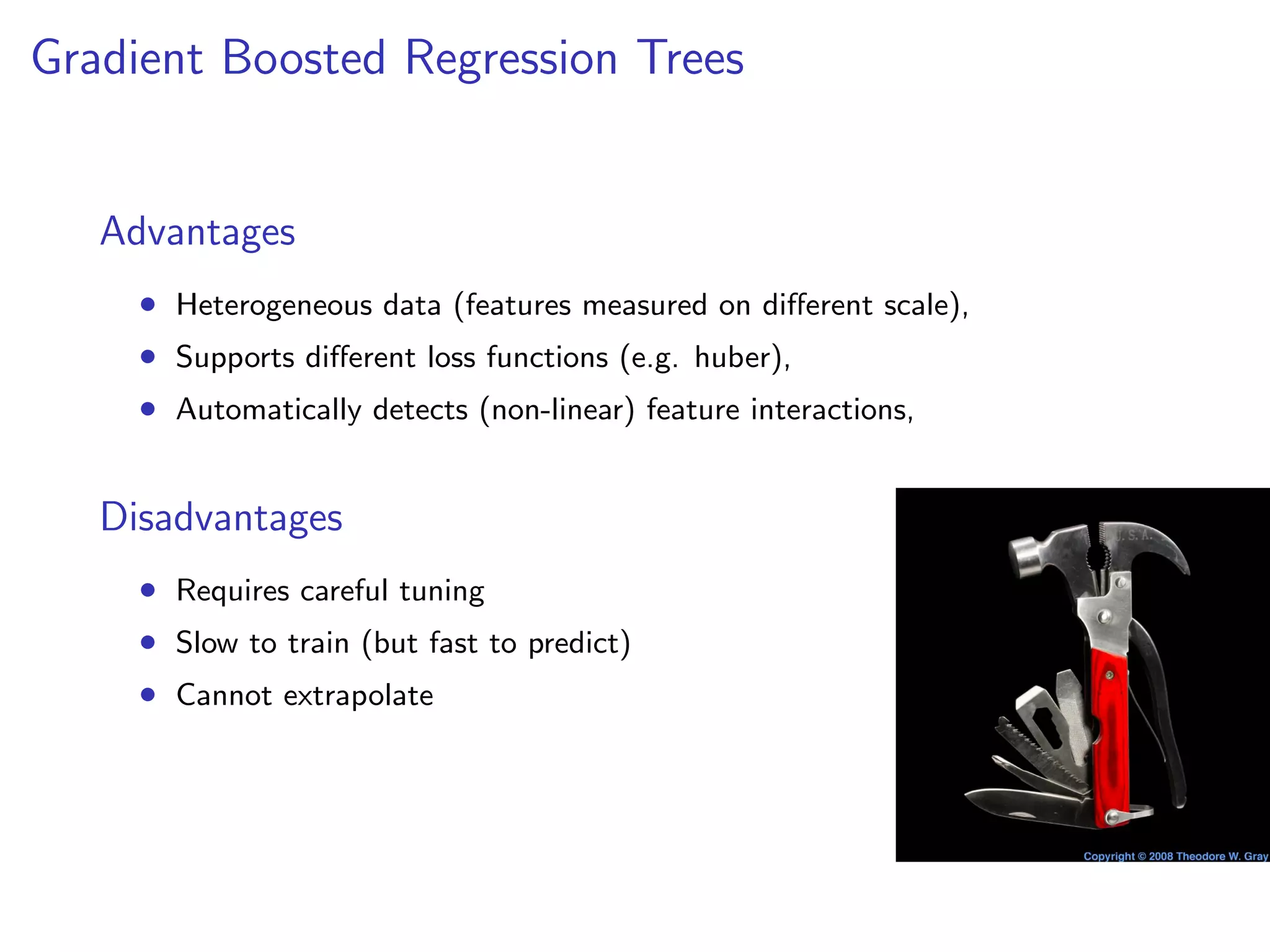
![Boosting AdaBoost [Y. Freund & R. Schapire, 1995] • Ensemble: each member is an expert on the errors of its predecessor • Iteratively re-weights training examples based on errors 2 1 0 1 2 3 x0 2 1 0 1 2 x1 2 1 0 1 2 3 x0 2 1 0 1 2 3 x0 2 1 0 1 2 3 x0 sklearn.ensemble.AdaBoostClassifier|Regressor](https://image.slidesharecdn.com/gradientboostedregressiontreesinscikitlearngilleslouppe-140327093600-phpapp01/75/Gradient-Boosted-Regression-Trees-in-Scikit-Learn-by-Gilles-Louppe-Peter-Prettenhofer-13-2048.jpg)
![Boosting AdaBoost [Y. Freund & R. Schapire, 1995] • Ensemble: each member is an expert on the errors of its predecessor • Iteratively re-weights training examples based on errors 2 1 0 1 2 3 x0 2 1 0 1 2 x1 2 1 0 1 2 3 x0 2 1 0 1 2 3 x0 2 1 0 1 2 3 x0 sklearn.ensemble.AdaBoostClassifier|Regressor Huge success • Viola-Jones Face Detector (2001) • Freund & Schapire won the G¨odel prize 2003](https://image.slidesharecdn.com/gradientboostedregressiontreesinscikitlearngilleslouppe-140327093600-phpapp01/75/Gradient-Boosted-Regression-Trees-in-Scikit-Learn-by-Gilles-Louppe-Peter-Prettenhofer-14-2048.jpg)
![Gradient Boosting [J. Friedman, 1999] Statistical view on boosting • ⇒ Generalization of boosting to arbitrary loss functions](https://image.slidesharecdn.com/gradientboostedregressiontreesinscikitlearngilleslouppe-140327093600-phpapp01/75/Gradient-Boosted-Regression-Trees-in-Scikit-Learn-by-Gilles-Louppe-Peter-Prettenhofer-15-2048.jpg)
![Gradient Boosting [J. Friedman, 1999] Statistical view on boosting • ⇒ Generalization of boosting to arbitrary loss functions Residual fitting 2 6 10 x 2.0 1.5 1.0 0.5 0.0 0.5 1.0 1.5 2.0 2.5 y Ground truth 2 6 10 x ∼ tree 1 2 6 10 x + tree 2 2 6 10 x + tree 3 sklearn.ensemble.GradientBoostingClassifier|Regressor](https://image.slidesharecdn.com/gradientboostedregressiontreesinscikitlearngilleslouppe-140327093600-phpapp01/75/Gradient-Boosted-Regression-Trees-in-Scikit-Learn-by-Gilles-Louppe-Peter-Prettenhofer-16-2048.jpg)
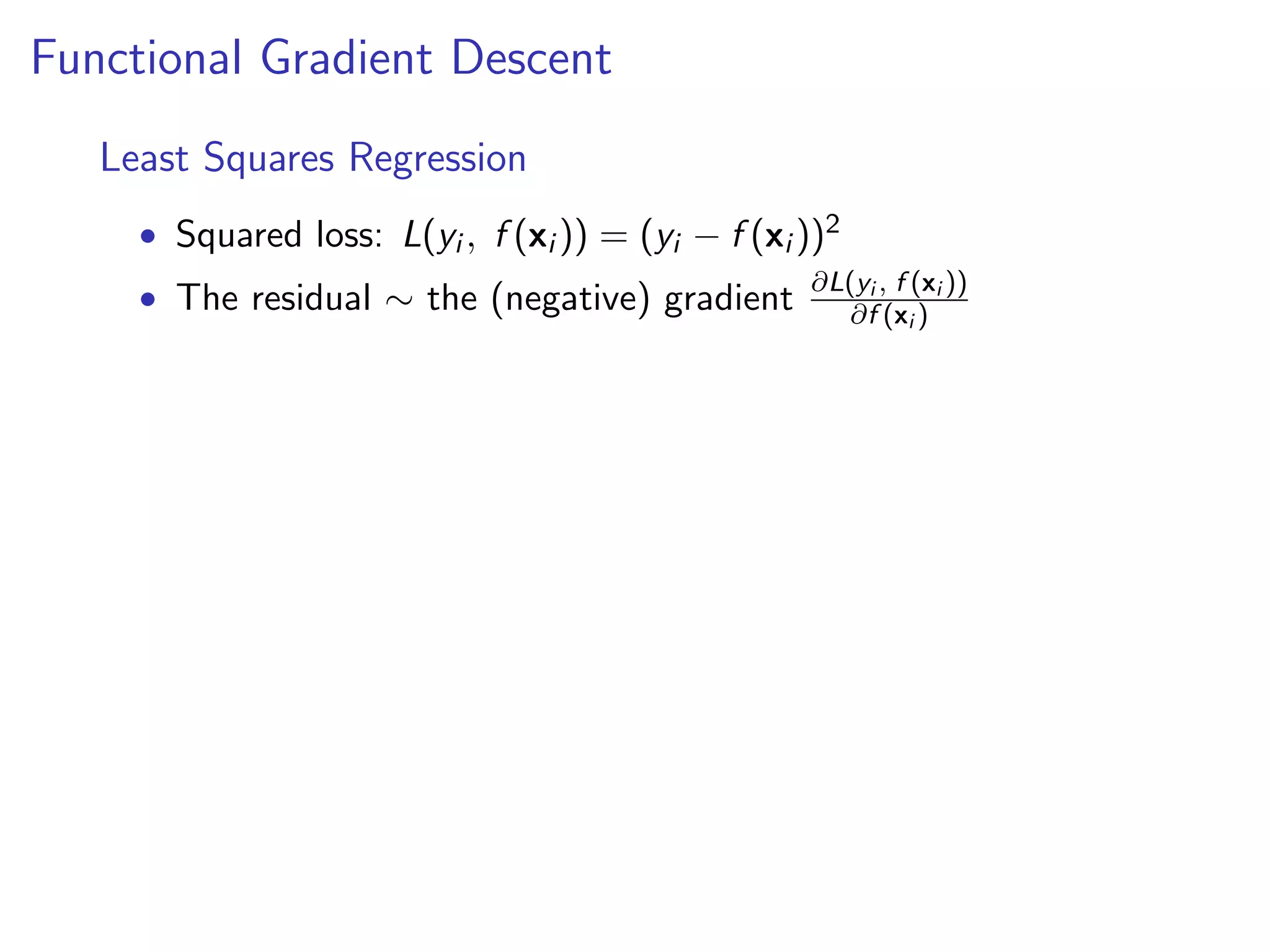
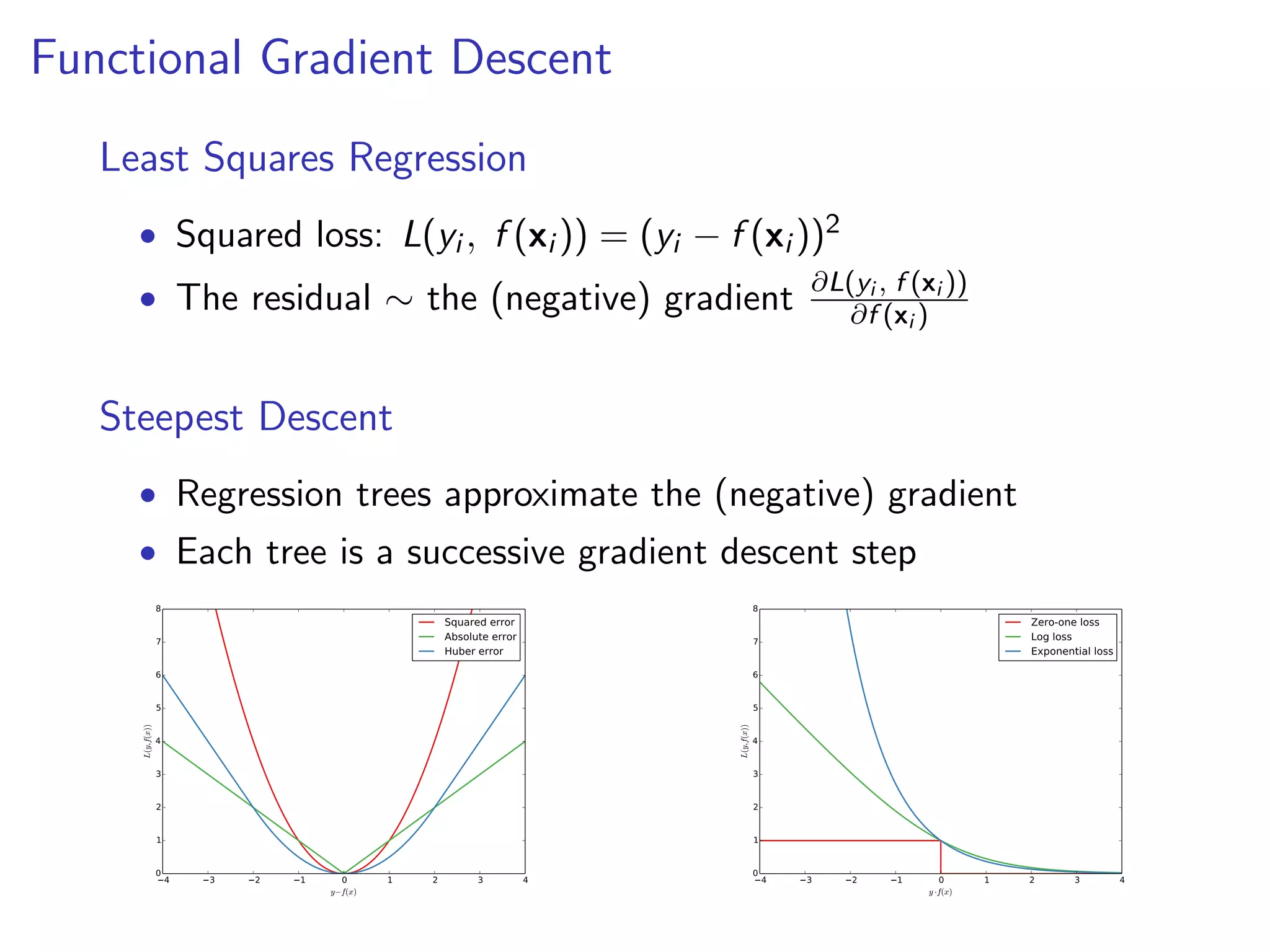

![GBRT in scikit-learn How to use it >>> from sklearn.ensemble import GradientBoostingClassifier >>> from sklearn.datasets import make_hastie_10_2 >>> X, y = make_hastie_10_2(n_samples=10000) >>> est = GradientBoostingClassifier(n_estimators=200, max_depth=3) >>> est.fit(X, y) ... >>> # get predictions >>> pred = est.predict(X) >>> est.predict_proba(X)[0] # class probabilities array([ 0.67, 0.33]) Implementation • Written in pure Python/Numpy (easy to extend). • Builds on top of sklearn.tree.DecisionTreeRegressor (Cython). • Custom node splitter that uses pre-sorting (better for shallow trees).](https://image.slidesharecdn.com/gradientboostedregressiontreesinscikitlearngilleslouppe-140327093600-phpapp01/75/Gradient-Boosted-Regression-Trees-in-Scikit-Learn-by-Gilles-Louppe-Peter-Prettenhofer-20-2048.jpg)
![Example from sklearn.ensemble import GradientBoostingRegressor est = GradientBoostingRegressor(n_estimators=2000, max_depth=1).fit(X, y) for pred in est.staged_predict(X): plt.plot(X[:, 0], pred, color=’r’, alpha=0.1) 0 2 4 6 8 10 x 8 6 4 2 0 2 4 6 8 10 y High bias - low variance Low bias - high variance ground truth RT d=1 RT d=3 GBRT d=1](https://image.slidesharecdn.com/gradientboostedregressiontreesinscikitlearngilleslouppe-140327093600-phpapp01/75/Gradient-Boosted-Regression-Trees-in-Scikit-Learn-by-Gilles-Louppe-Peter-Prettenhofer-21-2048.jpg)
![Model complexity & Overfitting test_score = np.empty(len(est.estimators_)) for i, pred in enumerate(est.staged_predict(X_test)): test_score[i] = est.loss_(y_test, pred) plt.plot(np.arange(n_estimators) + 1, test_score, label=’Test’) plt.plot(np.arange(n_estimators) + 1, est.train_score_, label=’Train’) 0 200 400 600 800 1000 n_estimators 0.0 0.5 1.0 1.5 2.0 Error Lowest test error train-test gap Test Train](https://image.slidesharecdn.com/gradientboostedregressiontreesinscikitlearngilleslouppe-140327093600-phpapp01/75/Gradient-Boosted-Regression-Trees-in-Scikit-Learn-by-Gilles-Louppe-Peter-Prettenhofer-22-2048.jpg)
![Model complexity & Overfitting test_score = np.empty(len(est.estimators_)) for i, pred in enumerate(est.staged_predict(X_test)): test_score[i] = est.loss_(y_test, pred) plt.plot(np.arange(n_estimators) + 1, test_score, label=’Test’) plt.plot(np.arange(n_estimators) + 1, est.train_score_, label=’Train’) 0 200 400 600 800 1000 n_estimators 0.0 0.5 1.0 1.5 2.0 Error Lowest test error train-test gap Test Train Regularization GBRT provides a number of knobs to control overfitting • Tree structure • Shrinkage • Stochastic Gradient Boosting](https://image.slidesharecdn.com/gradientboostedregressiontreesinscikitlearngilleslouppe-140327093600-phpapp01/75/Gradient-Boosted-Regression-Trees-in-Scikit-Learn-by-Gilles-Louppe-Peter-Prettenhofer-23-2048.jpg)
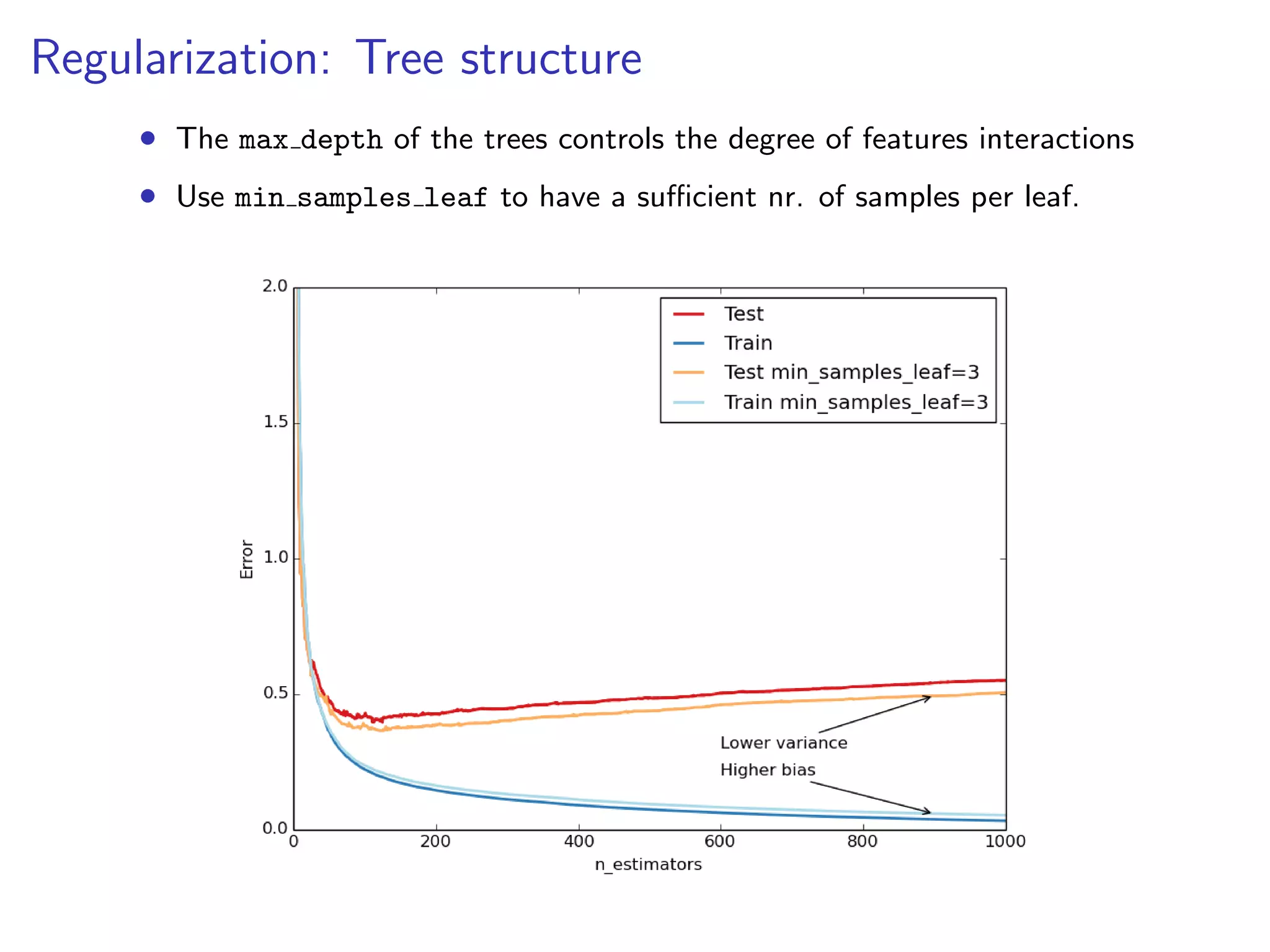

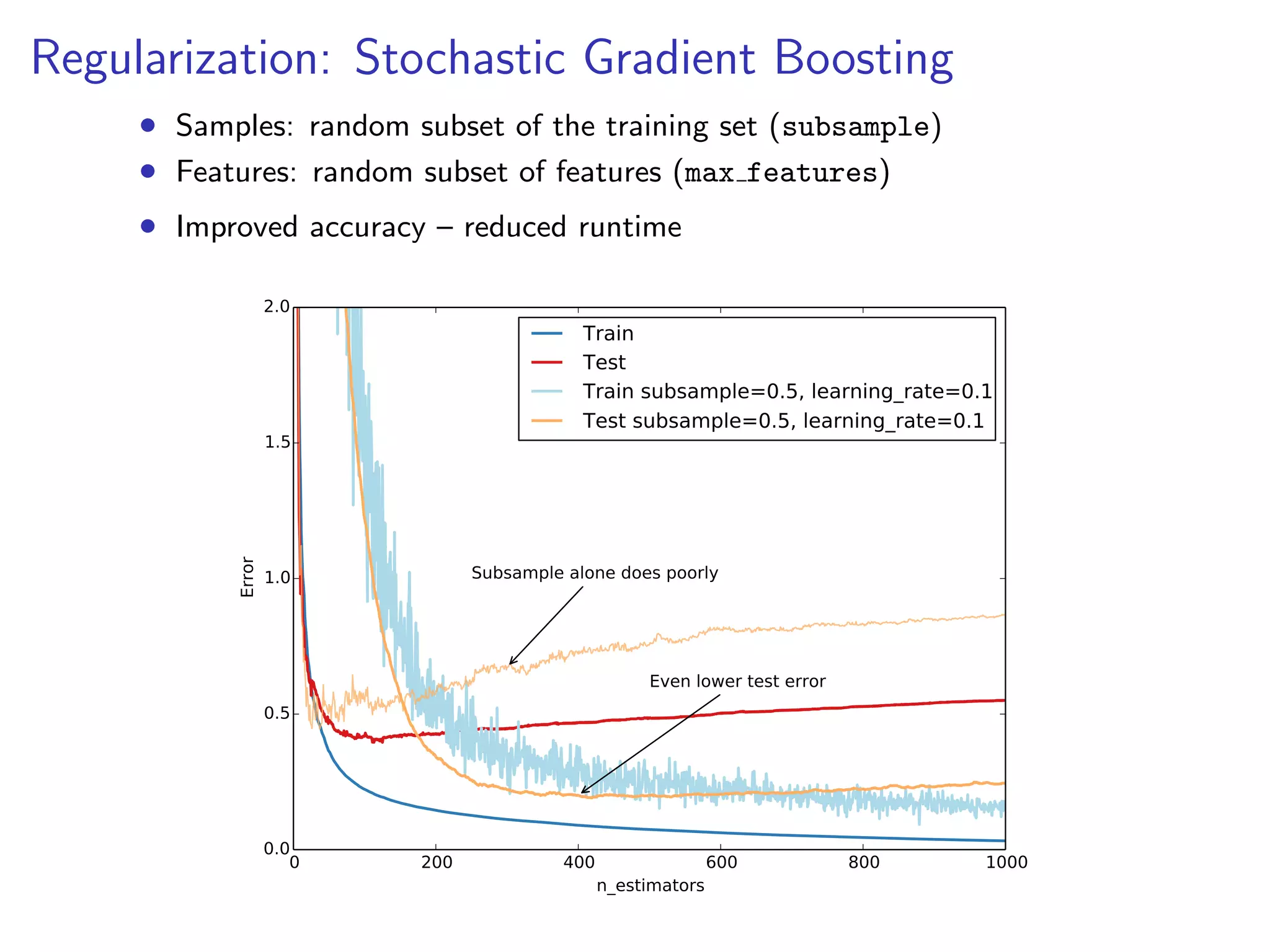
![Hyperparameter tuning 1. Set n estimators as high as possible (eg. 3000) 2. Tune hyperparameters via grid search. from sklearn.grid_search import GridSearchCV param_grid = {’learning_rate’: [0.1, 0.05, 0.02, 0.01], ’max_depth’: [4, 6], ’min_samples_leaf’: [3, 5, 9, 17], ’max_features’: [1.0, 0.3, 0.1]} est = GradientBoostingRegressor(n_estimators=3000) gs_cv = GridSearchCV(est, param_grid).fit(X, y) # best hyperparameter setting gs_cv.best_params_ 3. Finally, set n estimators even higher and tune learning rate.](https://image.slidesharecdn.com/gradientboostedregressiontreesinscikitlearngilleslouppe-140327093600-phpapp01/75/Gradient-Boosted-Regression-Trees-in-Scikit-Learn-by-Gilles-Louppe-Peter-Prettenhofer-27-2048.jpg)
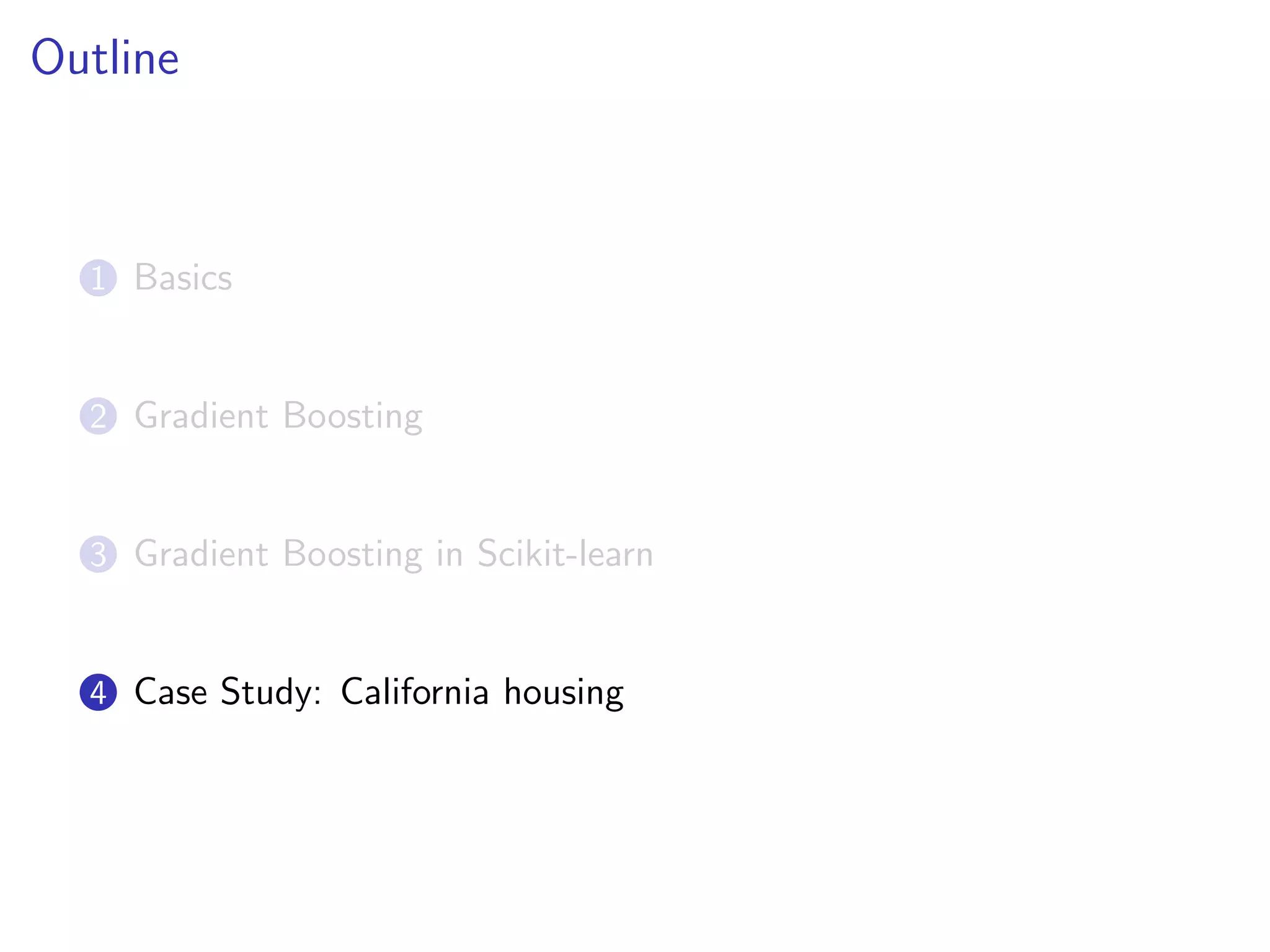

![Predictive accuracy & runtime Train time [s] Test time [ms] MAE Mean - - 0.4635 Ridge 0.006 0.11 0.2756 SVR 28.0 2000.00 0.1888 RF 26.3 605.00 0.1620 GBRT 192.0 439.00 0.1438 0 500 1000 1500 2000 2500 3000 n_estimators 0.0 0.1 0.2 0.3 0.4 0.5 error Test Train](https://image.slidesharecdn.com/gradientboostedregressiontreesinscikitlearngilleslouppe-140327093600-phpapp01/75/Gradient-Boosted-Regression-Trees-in-Scikit-Learn-by-Gilles-Louppe-Peter-Prettenhofer-30-2048.jpg)
![Model interpretation Which features are important? >>> est.feature_importances_ array([ 0.01, 0.38, ...]) 0.00 0.02 0.04 0.06 0.08 0.10 0.12 0.14 0.16 0.18 Relative importance HouseAge Population AveBedrms Latitude AveOccup Longitude AveRooms MedInc](https://image.slidesharecdn.com/gradientboostedregressiontreesinscikitlearngilleslouppe-140327093600-phpapp01/75/Gradient-Boosted-Regression-Trees-in-Scikit-Learn-by-Gilles-Louppe-Peter-Prettenhofer-31-2048.jpg)
![Model interpretation What is the effect of a feature on the response? from sklearn.ensemble import partial_dependence import as pd features = [’MedInc’, ’AveOccup’, ’HouseAge’, ’AveRooms’, (’AveOccup’, ’HouseAge’)] fig, axs = pd.plot_partial_dependence(est, X_train, features, feature_names=names) 1.5 3.0 4.5 6.0 7.5 MedInc 0.4 0.2 0.0 0.2 0.4 0.6 Partialdependence 2.0 2.5 3.0 3.54.0 4.5 AveOccup 0.4 0.2 0.0 0.2 0.4 0.6 Partialdependence 10 20 30 40 50 60 HouseAge 0.4 0.2 0.0 0.2 0.4 0.6 Partialdependence 4 5 6 7 8 AveRooms 0.4 0.2 0.0 0.2 0.4 0.6 Partialdependence 2.0 2.5 3.0 3.5 4.0 AveOccup 10 20 30 40 50 HouseAge -0.12 -0.05 0.02 0.090.16 0.23 Partial dependence of house value on nonlocation features for the California housing dataset](https://image.slidesharecdn.com/gradientboostedregressiontreesinscikitlearngilleslouppe-140327093600-phpapp01/75/Gradient-Boosted-Regression-Trees-in-Scikit-Learn-by-Gilles-Louppe-Peter-Prettenhofer-32-2048.jpg)

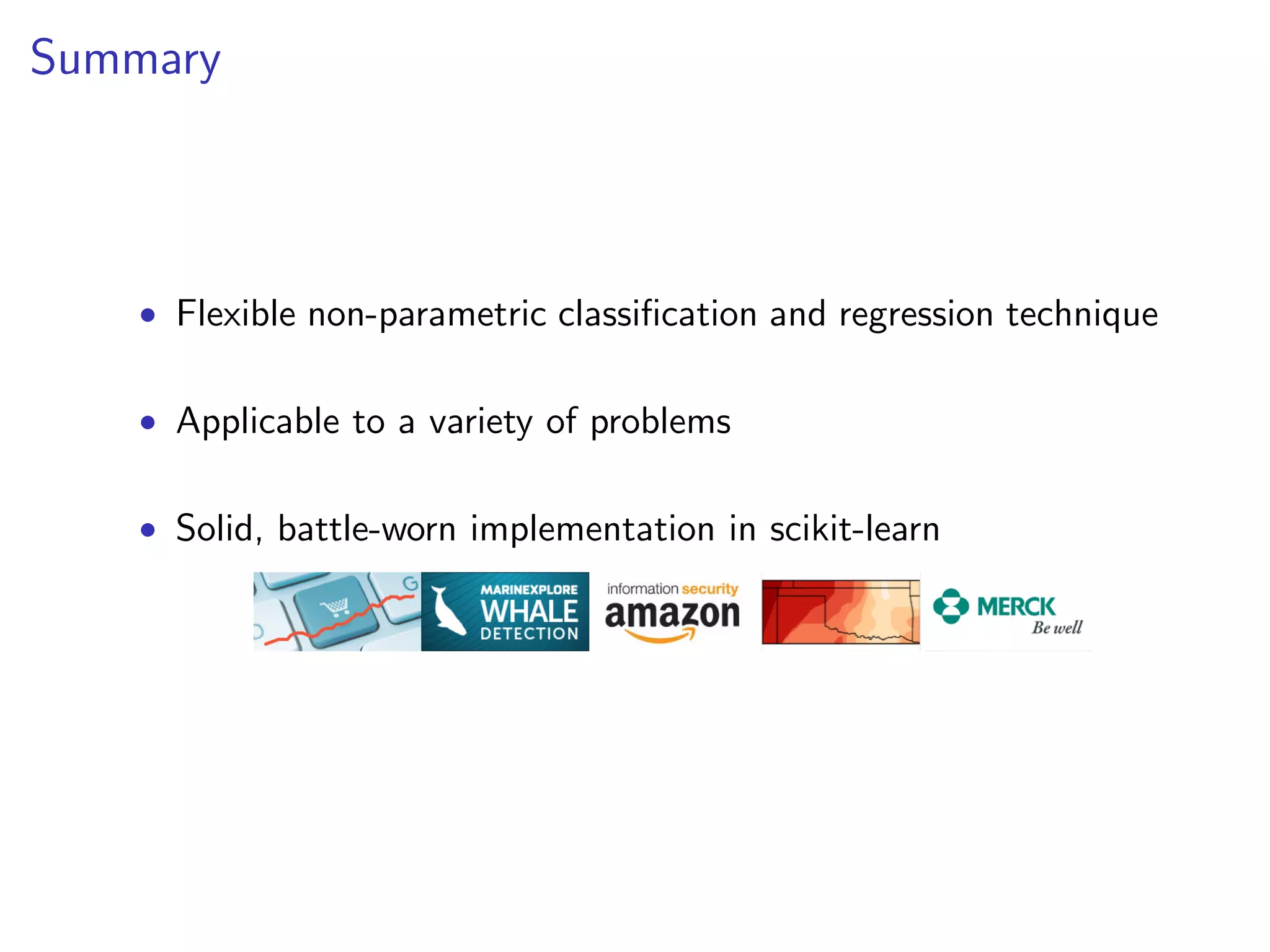

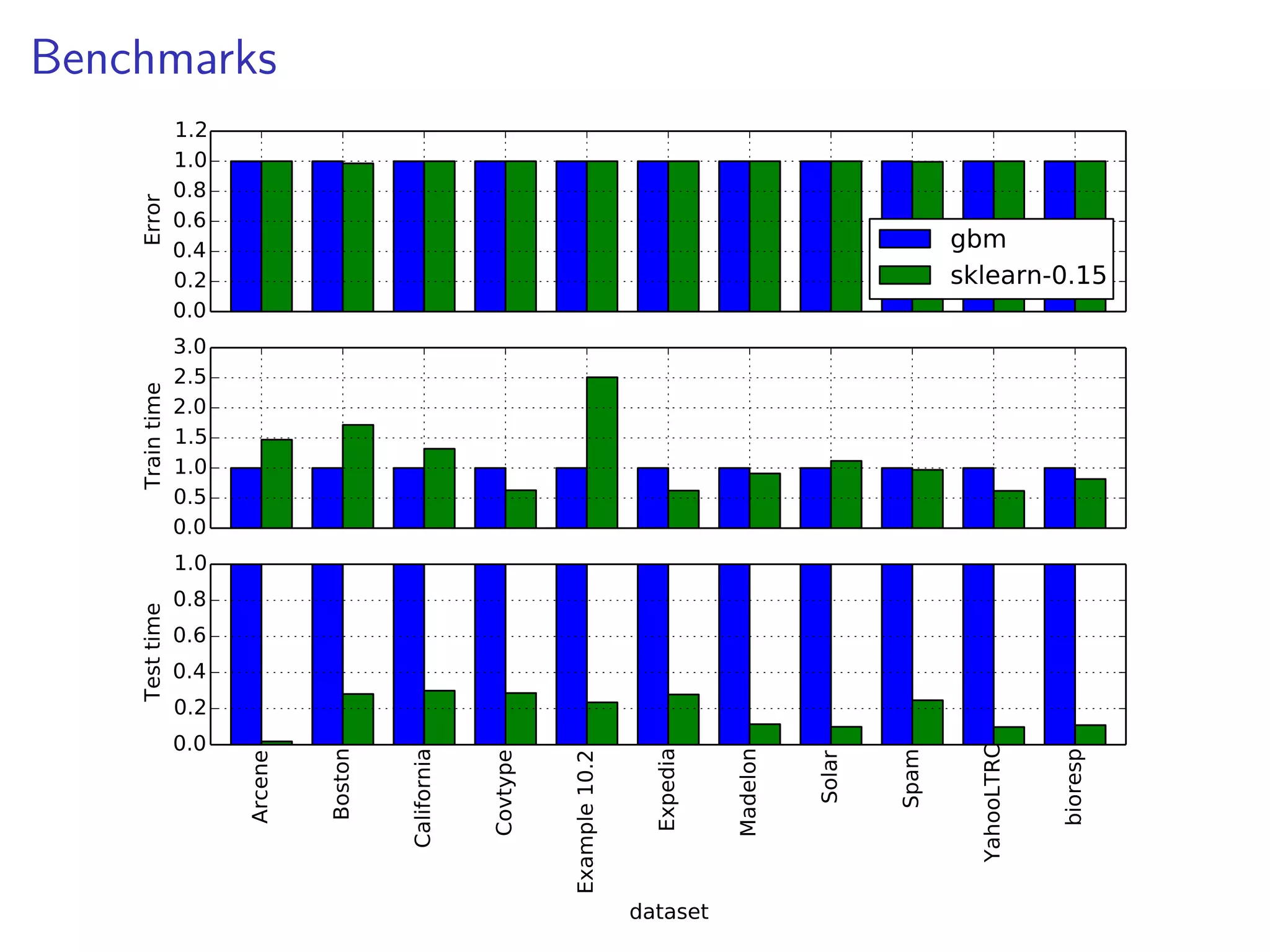

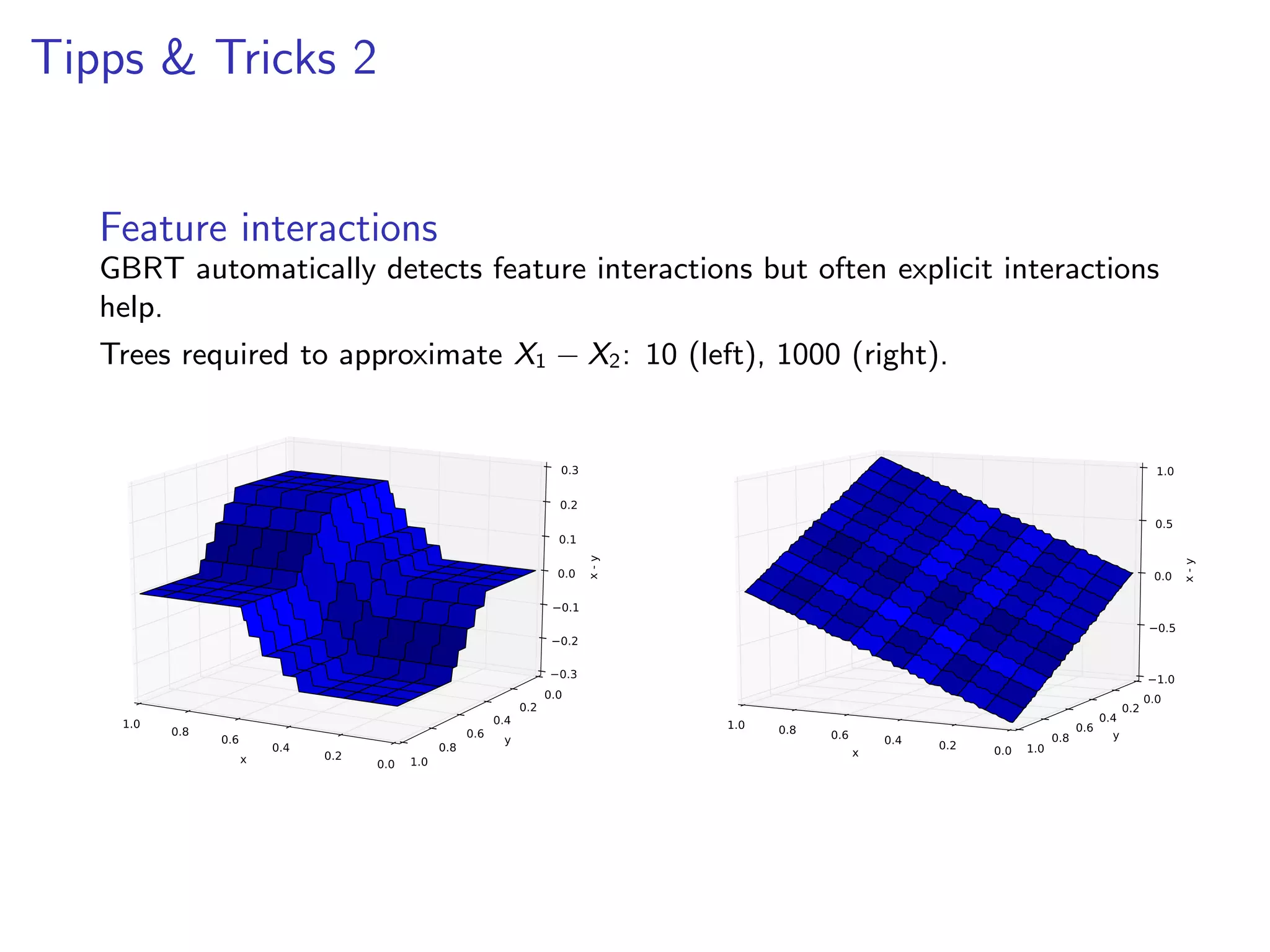
![Tipps & Tricks 3 Categorical variables Sklearn requires that categorical variables are encoded as numerics. Tree-based methods work well with ordinal encoding: df = pd.DataFrame(data={’icao’: [’CRJ2’, ’A380’, ’B737’, ’B737’]}) # ordinal encoding df_enc = pd.DataFrame(data={’icao’: np.unique(df.icao, return_inverse=True)[1]}) X = np.asfortranarray(df_enc.values, dtype=np.float32)](https://image.slidesharecdn.com/gradientboostedregressiontreesinscikitlearngilleslouppe-140327093600-phpapp01/75/Gradient-Boosted-Regression-Trees-in-Scikit-Learn-by-Gilles-Louppe-Peter-Prettenhofer-39-2048.jpg)